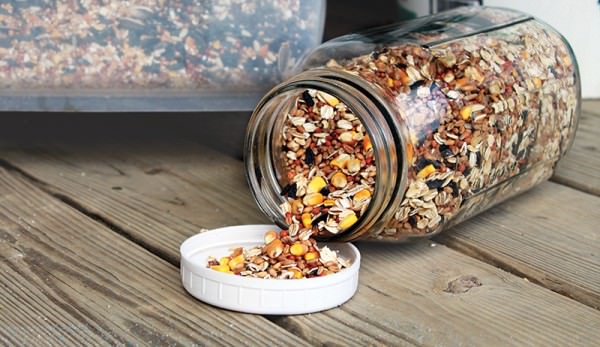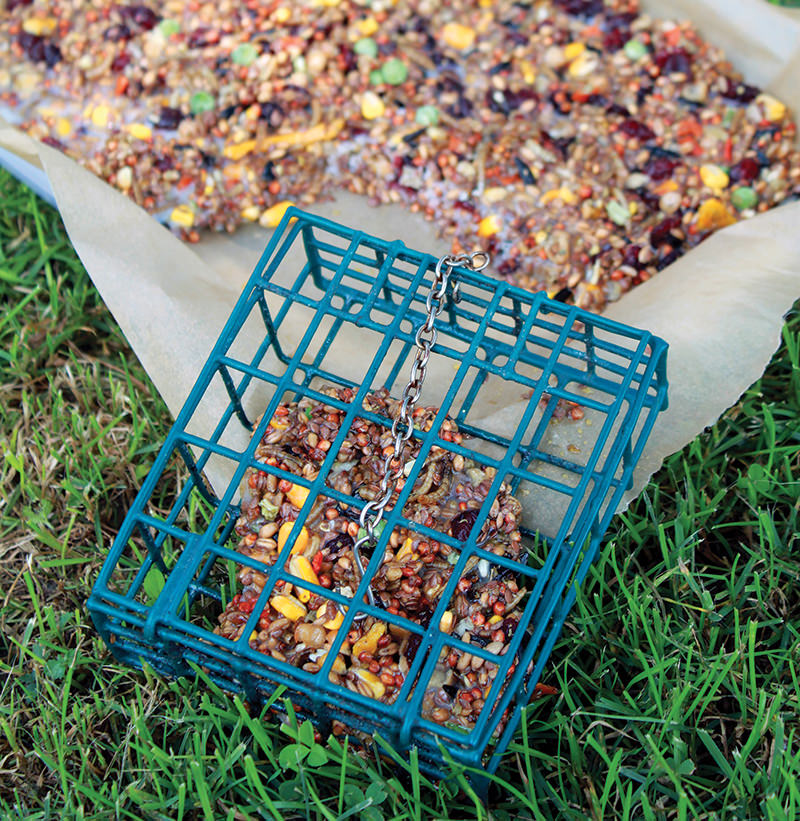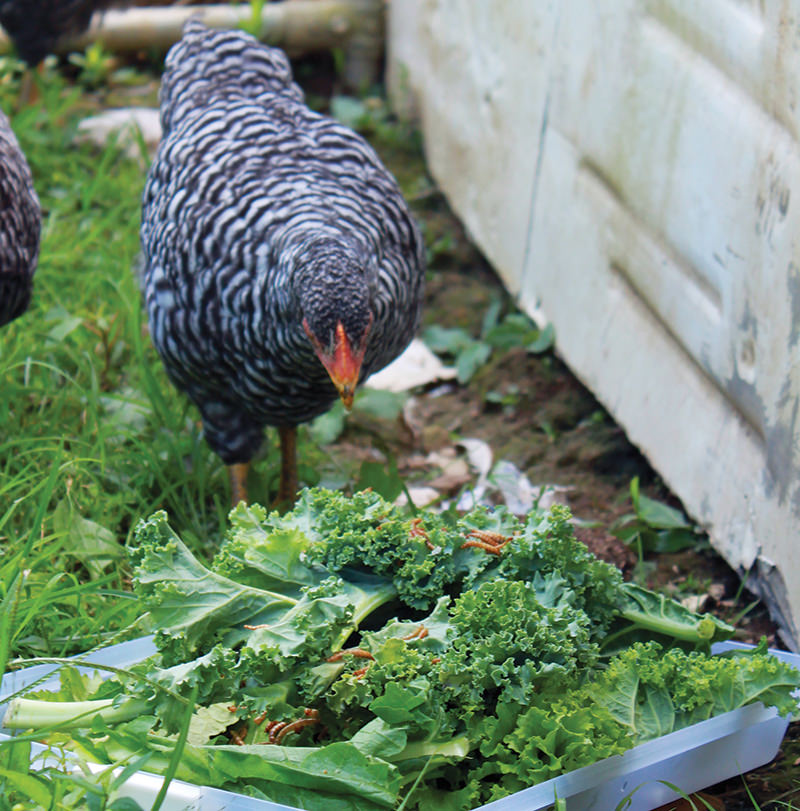
Winter might mean downtime for your garden, but it can wreak havoc on your fowl companions. Take care not to overfeed—scratch and treats should not exceed 10 percent of a hen’s diet—but keep in mind that your chickens need more calories during cold weather to stay warm.
According to educator and backyard chicken-keeper Dorothy Munn at Michigan State University Extension in “Tips For Managing Backyard Chickens in the Winter,” you should offer your birds additional high-energy feed such as corn or sunflower seeds to help meet their increased caloric needs in the cold weather. A good tactic is to provide this additional feed in the evening to help birds manage the overnight drop in temperatures more efficiently.
Munn also reminds us that active birds, especially in winter, are happy birds.
“Allowing birds to keep themselves busy by foraging will keep them from activities like pecking each other,” she writes. “Scattering corn or sunflower seeds in your coop at your evening feeding will allow birds the opportunity to scratch for these treats. Consider suspending a head of cabbage in your coop to keep birds entertained. Toss loose straw or add corn stalks, wood chips or brush to your run area; your birds will forage for any bugs that may find a home in the degrading surface.”
You can help to ease the stress and boredom of being cooped up in cooler temperatures and getting slim “peckings” in the chicken run by offering your feathered friends some homemade, scrumptious, energy-packed treats. So get your chicken-themed apron on, and let’s get to prepping, mixing and making!
From-Scratch Chicken Scratch
In “Feeding Chickens for Egg Production,” University of Kentucky poultry extension associate Jacquie Jacob states that chickens are compelled to scratch. “They use their toes to mix up litter or scrape the ground in search of various seeds, greens, grit or insects to eat,” she writes. “Spreading scratch grains—cracked, rolled or whole grains such as corn, barley, oats or wheat—encourages this behavior.” During winter, scratch helps keep chickens active when unfrozen foraging can be difficult to come by, but as with most treats, moderation is key.
“Chickens that eat too many scratch grains have less of an appetite for more nutritious feed,” Jacob writes. “If you are using scratch grains, feed them to chickens in the afternoon after birds have eaten complete feed and then provide only as much scratch grains as chickens can finish in 15 to 20 minutes.”
While chicken scratch is readily available at feed-supply stores, you can make your own with this simple recipe. Keep in mind that chickens don’t have teeth and natural grit can be difficult for them to source on the frozen tundra, so when feeding scratch grains, provide some store-bought grit to help them grind and digest the grains properly.
Ingredients
- 8 cups whole wheat
- 8 cups millet
- 6 cups cracked corn
- 6 cups unshelled, unsalted sunflower seeds
- 12 cups whole oats
- 6 cups flax seed
Preparation
Combine dry ingredients, and store in airtight container until ready to use.
Copycat Forage Cakes

Many wild-bird species including woodpeckers, sapsuckers, nuthatches and warblers love suet, which is basically a fat-packed treat. Traditionally pressed into cakes, suet provides birds with a concentrated source of protein, one of the most important elements in helping them maintain energy. In Backyard Birding: A Guide to Attracting and Identifying Birds (2011), author Randi Minetor writes that overwintering birds require energy for warmth. “In fact, some birds must eat constantly all day to take in the protein and fat they need to survive in frigid winter’s nights,” he notes.
With a few poultry-approved ingredient substitutions, you can make your own protein- and fat-packed suet cakes for your flock with the following recipe. You could even make this treat into a cute gift for fellow chicken keepers by freezing it in a miniature Bundt pan and presenting it with a ribbon through the center for hanging. Note: The melting point for coconut oil is 74 degrees F, so this works best as a winter treat and should be fed in a cool, shaded area.
Ingredients
- 2 cups From-Scratch Chicken Scratch (see above)
- 1/2 cup dried mealworms or fish meal
- 1/2 cup dried vegetables (e.g., peas, carrots, celery and/or beets)
- 1/2 cup dried cranberries
- 1 tablespoon dried parsley or oregano
- 1/4 cup molasses or sorghum
- 1 1/4 cups melted coconut oil, suet, tallow or lard
Preparation
In a large bowl, combine the dry ingredients. Drizzle mixture with molasses or sorghum, stirring to coat well. Add oil, and work into the mixture by hand. Press mixture into a parchment-lined baking pan to 1-inch thickness, and refrigerate to set.
Break into squares to fit a suet-cake holder, if using, and freeze until ready to feed.
Don’t provide more than your birds can consume within 20 or 30 minutes to reduce spoilage and rodent issues. Hang out of direct sun to prevent melting.
Chip Off the Ol’ Block

The traditional calcium supplement for a layer diet is oyster shells, which look a bit like grit and are ground to the point that hens don’t have to work to eat them. This recipe will provide some additional calcium for those eggs, and the energy needed to get those eggs laid in the dead of winter!
Ingredients
- 4 cups From-Scratch Chicken Scratch (see above)
- 1/2 cup oyster shells or crushed limestone
- 1/2 cup molasses or sorghum
- 1 1/2 cups coconut oil, tallow or lard
Preparation
Combine dry ingredients in large bowl. Drizzle with molasses, stirring to coat well. Pour mixture into small bucket or sanitized plastic milk jug with top cut off.
Melt coconut oil, and pour over mixture. Let cool, and remove from container to serve.
If you want to hang the block, consider inserting a chain or loop of twine before adding the melted oil; lay a stick across the container’s top for the twine to rest on while the mixture sets.
Got Grain Treat Balls

Being literally cooped up during late fall and winter can turn your docile flock into a bunch of grouchy hen-peckers! While you should let them out to forage when appropriate, some days are just going to be too cold, wet, snowy or icy. During those days, your hens will need something to peck (besides each other), and these treat balls are a fun way to keep the winter doldrums at bay for a few hours at least.
Ingredients
- 1 cup unshelled, unsalted sunflower seeds
- 1 cup unsalted squash seeds
- 1 cup dried veggies (e.g., peas, carrots,peppers and/or celery)
- 1/2 cup dried fruits
Preparation
In a large bowl, combine all the ingredients.
Cut a line across four holes in a golf-ball-sized Wiffle ball, squeeze to open and push through bowl to fill with mix or wedge a funnel in the opening and pour mixture into ball. Allow to close and roll or hang in coop run.
Seal unused mixture in airtight container. Empty any uneaten snacks from ball, rinse and let dry for the next play date.
No-Chicken Salad

Max out your cool-weather crop’s potential by tossing the leafy greens from crops and winter grasses into a delicious salad for your chickens. Just keep in mind that excessive table scraps can adversely affect egg production.
Ingredients
- handful broccoli greens, turnip greens and/or mustard greens
- handful kale
- handful clover
- 2 tablespoons fresh oregano, destemmed
- dried mealworms to garnish (optional)
Preparation
Combine fresh greens and oregano, sprinkle with meal worms and serve. Clean out and compost any greens that aren’t consumed within 10 to 20 minutes to avoid spoilage or rodent issues.
Winter certainly has its unique challenges for chickens and chicken keepers alike. But with a little TLC and DIY, you can keep your coop cozy and your flock functioning through the coldest of nights.
This article originally appeared in the November/December 2016 issue of Chickens.




